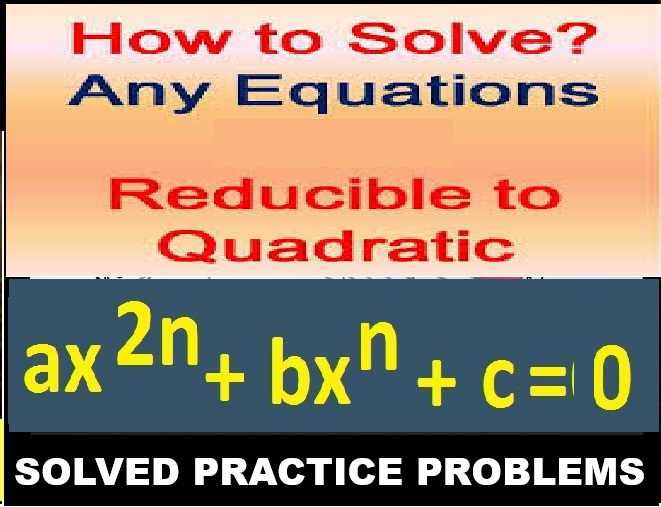Exe-2B and 2C Work Energy and Power ICSE Class-10 Concise Selina Physics Solutions Chapter-2. We Provide Step by Step Answer of Exercise-2(A), MCQs-2(A), Numericals-2(A), Exercise-2(B), MCQ-2(B), Numericals-2(B), Exercise-2(C) and MCQs-2(C) , Numericals-2(C) Questions of Exercise-2 Work Energy and Power ICSE . Visit official Website CISCE for detail information about ICSE Board Class-10.
| Board | ICSE |
| Publications | Selina Publication |
| Subject | Physics |
| Class | 10th |
| Chapter-2 | Work Energy and Power (Exe-2B and 2C) |
| Book Name | Concise |
| Topics | Solution of Exe-2(A), MCQs-2(A), Numericals-2(A), Exe-2(B), MCQ-2(B), Numericals-2(B), Exe-2(C) and MCQs-2(C) , Numericals-2(C) |
| Academic Session | 2021-2022 |
Exe-2B and 2C Work Energy and Power ICSE Class-10 Concise Selina Physics Solutions Chapter-2
-: Select Exercise :-
Exe-2(A), MCQs-2(A), Numericals-2(A),
Exe-2(B), MCQ-2(B), Numericals-2(B), Exe-2(C) and MCQs-2(C) , Numericals-2(C)
Exe- 2 (B) Work, Energy and Power Selina Physics Solution
Exe-2B and 2C Work Energy and Power ICSE Class-10 Concise
Page 40
Question 1
What are the two forms of mechanical energy?
Answer 1
Two forms of mechanical energy are:
(i) Kinetic energy
(ii) Potential energy
Question 2
Name the form of energy which a wound up watch spring possesses.
Answer 2
Elastic potential energy is possessed by wound up watch spring.
Question 3
Name the type of energy (kinetic energy K or potential energy U) possessed in the following cases:
(a) A moving cricket ball
(b) A compressed spring
(c) A moving bus
(d) A stretched wire
(e) An arrow shot out of a bow.
(f) A piece of stone placed on the roof.
Answer 3
(a)Kinetic energy (K)
(b)Potential energy (U)
(c)Kinetic energy (K)
(d)Potential energy (U)
(e)Kinetic energy (K)
(f)Potential energy (U)
Question 4
Define the term potential energy of a body. Name its two forms and given one example of each.
Answer 4
Potential energy: The energy possessed by a body by virtue of its specific position (or changed configuration) is called the potential energy.
Different forms of P.E. are as listed below:
(i) Gravitational potential energy: The potential energy possessed by a body due to its position relative to the centre of Earth is called its gravitational potential energy.
Example: A stone at a height has gravitational potential energy due to its raised height.
(ii) Elastic potential energy: The potential energy possessed by a body in the deformed state due to change in its configuration is called its elastic potential energy.
Example: A compressed spring has elastic potential energy due to its compressed state.
Question 5 (Exe-2B and 2C Work Energy and Power ICSE)
Name the form of energy which a body may possess even when it is not in motion. Give an example to support your answer.
Answer 5
Potential energy is possessed by the body even when it is not in motion. For example: a stone at a height has the gravitational potential energy due to its raised position.
Question 6
What is meant by gravitational potential energy? Derive an expression for it for a body placed at a height above the ground.
Answer 6
Gravitational potential energy is the potential energy possessed by a body due to its position relative to the centre of earth.
For a body placed at a height above the ground, the gravitational potential energy is measured by the amount of work done in lifting it up to that height against the force of gravity.
Let a body of mass m be lifted from the ground to a vertical height h. The least upward force F required to lift the body (without acceleration) must be equal to the force of gravity (=mg) on the body acting vertically downwards. The work done W on the body in lifting it to a height h is
W= force of gravity (mg) x displacement (h)
=mgh
This work is stored in the body when it is at a height h in the form of its gravitational potential energy.
Gravitational potential energyU= mgh
Question 7
Write an expression for the potential energy of a body of mass m placed at a height h above the earth’s surface. State the assumptions made, if any.
Answer 7
The work done W on the body in lifting it to a height h is
W= force of gravity (mg) x displacement (h)
=mgh
This work is stored in the body when it is at a height h in the form of its gravitational potential energy.
Gravitational potential energy U= mgh
Question 8
What do you understand by the kinetic energy of a body?
Answer 8
A body in motion is said to possess the kinetic energy. The energy possessed by a body by virtue of its state of motion is called the kinetic energy.
Question 9
(a) A body of mass m is moving with a velocity v. Write the expression for its kinetic energy.
(b) Show that the quantity 2K/v2 has the unit of mass, where K is the kinetic energy of the body.
Answer 9

Question 10
State the work–energy theorem.
Answer 10
According to the work-energy theorem, the work done by a force on a moving body is equal to the increase in its kinetic energy.
Question 11
A body of mass m is moving with a uniform velocity u. A force is applied on the body due to which its velocity increases from u to v. How much work is being done by the force?
Answer 11
Body of mass m is moving with a uniform velocity u. A force is applied on the body due to which its velocity changes from u to v and produces an acceleration a in moving a distance S.Then,
Work done by the force= force x displacement
W = F x S———(i)
From relation : v2 = u2+2 a S
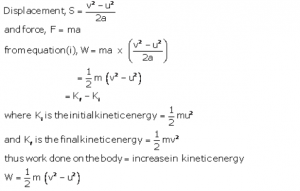
Question 12 (Exe-2B and 2C Work Energy and Power ICSE)
A light mass and a heavy mass have equal momentum. Which will have more kinetic energy?
[Hint: kinetic energy K=p2/2m where p is the momentum]
Answer 12
Kinetic energy, K=p2/2m where p is the momentum.
Both the masses have same momentum p. The kinetic energy, K is inversely proportional to mass of the body.
Hence light mass body has more kinetic energy because smaller the mass, larger is the kinetic energy.
Page 40
Question 13
Two bodies A and B of masses m and M (M≫ m) have same kinetic energy. Which body will have more momentum?
Answer 13
Kinetic energy is related to momentum and mass as √2mK
As the kinetic energy of both bodies are same, momentum is directly proportional to square root of mass.
Now, mass of body B is greater than that of body A.Hence, body B will have more momentum than body A.
Question 14
Name the three forms of kinetic energy and give one example of each.
Answer 14
The three forms of kinetic energy are:
(i) Translational kinetic energy- example: a freely falling body
(ii) Rotational kinetic energy-example: A spinning top.
(iii) Vibrational kinetic energy-example: atoms in a solid vibrating about their mean position.
Question 15
State two differences between the potential energy and the kinetic energy.
Answer 15
| Potential energy (U) | Kinetic energy (K) |
| 1. The energy possessed by a body by virtue of its specific position or changed configuration is called potential energy. | 1.The energy possessed by a body by virtue of its state of motion is called the kinetic energy. |
| 2.Two forms of potential energy are gravitational potential energy and elastic potential energy. | 2. Forms of kinetic energy are translational, rotational and vibrational kinetic energy. |
| 3.Example: A wound up watch spring has potential energy. | 3. For example: a moving car has kinetic energy. |
Question 16
Complete the following sentences:
(a)The kinetic energy of a body is the energy by virtue of its _______.
(b)The potential energy of a body is the energy by virtue of its _______.
Answer 16
(a)Motion.
(b)Position.
Question 17
When an arrow is shot from a bow, it has kinetic energy in it. Explain briefly from where does it get its kinetic energy?
Answer 17
When the string of a bow is pulled, some work is done which is stored in the deformed state of the bow in the form of its elastic potential energy. On releasing the string to shoot an arrow, the potential energy of the bow changes into the kinetic energy of the arrow which makes it move.
Question 18
A ball is placed on a compressed spring. What form of energy does the spring possess? On releasing the spring, the ball flies away. Give a reason.
Answer 18
The compressed spring has elastic potential energy due to its compressed state. When it is released, the potential energy of the spring changes into kinetic energy which does work on the ball if placed on it and changes into kinetic energy of the ball due to which it flies away.
Question 19 (Exe-2B and 2C Work Energy and Power ICSE)
A pebble is thrown up. It goes to a height and then comes back on the ground. State the different changes in form of energy during its motion.
Answer 19
When the pebble is thrown upwards, the kinetic energy in it is converted to potential energy.
At the top point in its motion, its kinetic energy is completely converted into potential energy.
While coming down, the potential energy is converted into kinetic energy and at the bottom the potential energy is completely converted to kinetic energy.
Question 20
In what way does the temperature of water at bottom of a waterfall differ from the temperature at the top? Explain the reason.
Answer 20
When water falls from a height, the potential energy stored in water at a height changes into the kinetic energy of water during the fall. On striking the ground, a part of the kinetic energy of water changes into the heat energy due to which the temperature of water rises.
Question 21
Name the form of energy in which potential energy can change.
Answer 21
Kinetic energy.
Question 22
Name the form of mechanical energy, which is put to use.
Answer 22
Kinetic energy.
Question 23
Name six different forms of energy?
Answer 23
The six different forms of energy are:
(a) Solar energy
(b) Heat energy
(c) Light energy
(d) Chemical or fuel energy
(e) Hydro energy
(f) Nuclear energy
Question 24
Energy can exist in several forms and may change from one form to another. For each of the following, state the energy changes that occur in:
(a) the unwinding of a watch spring
(b) a loaded truck when started and set in motion,
(c) a car going uphill,
(d) photosynthesis in green leaves,
(e) charging of a battery,
(f) respiration,
(g) burning of a match stick,
(h) explosion of crackers.
Answer 24
(a) Potential energy of wound up spring converts into kinetic energy.
(b) Chemical energy of petrol or diesel converts into mechanical energy (kinetic energy)
(c) Kinetic energy to potential energy
(d) Light energy changes into chemical energy
(e) Electrical energy changes into chemical energy
(f) Chemical energy changes into heat energy
(g) Chemical energy changes into heat and light energy
(h) Chemical energy changes into heat, light and sound energy
Question 25
State the energy changes in the following cases while in use:
(a)Loudspeaker
(b)A steam engine
(c)Microphone
(d)Washing machine
(e)A glowing electric bulb
(f)Burning coal
(g)A solar cell
(h)Bio-gas burner
(i)An electric cell in a circuit
(j)A petrol engine of a running car
(k)An electric iron
(l)A ceiling fan
(m)An electromagnet.
Answer 25
(a)Electrical energy into sound energy
(b)Heat energy into mechanical energy
(c)Sound energy into electrical energy
(d)Electrical energy to mechanical energy
(e)Electrical energy into light energy
(f)Chemical energy to heat energy
(g)Light energy into electrical energy
(h)Chemical energy into heat energy
(i)Chemical energy into electrical energy
(j)Chemical energy to mechanical energy
(k)Electrical energy into heat energy
(l)electrical energy into mechanical enegy
(m)Electrical energy into magnetic energy.
Question 26 (Exe-2B and 2C Work Energy and Power ICSE)
Name the process used for producing electricity from the nuclear energy.
Answer 26
The process used to transfer nuclear energy to electrical energy is called nuclear fission.
Question 27
Is it practically possible to convert a form of energy completely into the other useful form? Explain your answer.
Answer 27
No. This is because, whenever there is conversion of energy from one form to another apart of the energy is dissipated in the form of heat which is lost to surroundings.
Question 28
What is degraded energy?
Answer 28
During the transformation of energy from one form to another desired form, some part of the energy gets converted to some undesirable form or a part of it is lost to the surroundings due to the friction or radiations which cannot be used for any productive purpose. This is called dissipation of energy, and this undesirable part of energy is called degraded energy.
Question 29
What do you mean by degradation of energy? Explain it by taking one example of your daily life.
Answer 29
During the transformation of energy from one form to another desired form, some part of energy is converted to some undesirable form or a part of it is lost to the surroundings due to the friction or radiations which cannot be used for any productive purpose. This is called dissipation of energy or degradation of energy.
Example: When a light bulb glows, a major part of the electrical energy utilised is converted to heat energy while some part is converted to useful light energy.
Question 30
Complete the following sentence:
The conversion of part of energy into an undesirable form is called……………. .
Answer 30
Conversion of part of energy into an undesirable form is called dissipation of energy/degradation of energy.
MCQs-2 (B) Work Energy and Power ICSE Physics Solutions
Exe-2B and 2C Work Energy and Power ICSE Class-10 Concise
Page 41
Question 1
A body at a height possesses:
(a) Kinetic energy
(b) Potential energy
(c) Solar energy
(d) Heat energy
Answer 1
(b) Potential energy
Question 2
In an electric cell while in use, the change in energy is from:
(a) Electrical to mechanical
(b) Electrical to chemical
(c) Chemical to mechanical
(d) Chemical to electrical
Answer 2
(d) Chemical to electrical
Numericals- 2 (B) Work, Energy and Power
Exe-2B and 2C Work Energy and Power ICSE Class-10 Concise
Page 41
Question 1
Two bodies of equal masses are placed at heights h and 2h. Find the ratio of their gravitational potential energies.
Answer 1
Height H1= h
Height H2= 2h
Mass of body 1= m
Mass of body 2= m
Gravitational potential energy of body 1 =mgH1= mgh
Gravitational potential energy of Body 2=mgH2= mg (2h)
Ratio of gravitational potential energies
= mgh/mg(2) = mgh/2mgh = 1/2 = 1:2
Question 2 (Exe-2B and 2C Work Energy and Power ICSE)
Find the gravitational potential energy of 1kg mass kept at a height of 5m above the ground if g =10ms-2.
Answer 2
Mass , m=1kg
Height, h=5m
Gravitational potential energy= mgh
=1 x 10 x5=50J
Question 3
A box of weight 150kgf has gravitational potential energy stored in it equal to 14700J. Find the height of the box above the ground.
(Take g= 9.8N/kg-1).
Answer 3
Gravitational potential energy = 14700 J
Force of gravity = mg = 150 x 9.8N/kg = 1470N
Gravitational potential energy = mgh
14700 = 1470 x h
h = 10 m
Question 4
A body of mass 5 kg falls from a height of 10 m to 4 m. Calculate: (i) the loss in potential energy of the body, (ii) the total energy possessed by the body at any instant? (Take g = 10 ms-2).
Answer 4
(i) Mass of the body, M = 5 kg
Potential energy at height 10 m = mgh
= 5 × 10 × 10
= 500 J
Potential energy at height 4 m = mgh
= 5 × 10 × 4
= 200 J
Loss in potential energy = (500 – 200) J
= 300 J
(ii) The total energy possessed by the body at any instant remains constant for free fall
It is equal to the sum of P.E and K.E
Thus, at height 10 m, K.E = 0
Therefore total energy = P.E + K.E
Total energy = 500 + 0
= 500 J
Page 42
Question 5
Calculate the height through which a body of mass 0.5 kg should be lifted if the energy spent in doing so is 1.0 J. Take g = 10m/s–2.
Answer 5
Mass = 0.5 kg
Energy = 1 J
Gravitational potential energy = mgh
1 = 0.5 x 10 x h
1 = 5h
Height, h = 0.2 m
Question 6
A boy weighing 25 kgf climbs up from the first floor at height 3 m above the ground to the third floor at height 9 m above the ground. What will be the increase in his gravitational potential energy?
(Take g=10 N kg-1).
Answer 6
Force of gravity on boy=mg= 25 x 10 =250N
Increase in gravitational potential energy= Mg (h2-h1)
= 250 x (9-3)
=250 x6=1500 J
Question 7
A vessel containing 50 kg of water is placed at a height 15m above the ground. Assuming the gravitational potential energy at ground to be zero, what will be the gravitational potential energy of water in the vessel? (g = 10ms–2).
Answer 7
Mass of water, m = 50 kg
Height, h = 15 m
Gravitational potential energy = mgh
=50 x 10 x 15
=7500 J
Question 8
A man of mass 50 kg climbs up a ladder of height 10m. Calculate: (i) the work done by the man, (ii) the increase in his potential energy.
(g= 9.8m s–2).
Answer 8
Mass of man=50kg
Height of ladder, h2=10m
(i)Work done by man =mgh2
=50 x 9.8 x10= 4900J
(ii)increase in his potential energy:
Height,h2= 10m
Reference point is ground, h1=0m
Gravitational potential energy= Mg (h2-h1)
= 50 x 9.8 x (10-0)
= 50 x 9.8 x 10= 4900 J
Question 9
A block A, whose weight is 100N, is pulled up a slope of length 5m by means of a constant force F (=100N) as illustrated.
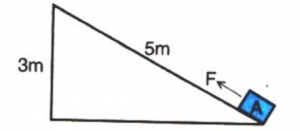
(a) What is the work done by the force F in moving the block A, 5m along the slope?
(b) What is the increase in potential energy of the block A?
(c) Account for the difference in the work done by the force and the increase in potential energy of the block.
Answer 9
(a) Work done by the force in moving the block 5m along the slope =Force x displacement in the direction of force =150 x 5=750 J
(b) The potential energy gained by the block U = mgh where h =3 m potential energy gained by the block
(c) =200 x 3=600 J
(d) The difference i.e., 150 J energy is used in doing work against friction between the block and the slope, which will appear as heat energy.
Question 10 (Exe-2B and 2C Work Energy and Power ICSE)
Find the kinetic energy of a body of mass 1kg moving with a uniform velocity of 10m s-1.
Answer 10
Mass, m =1kg
Velocity, v=10m/s
Kinetic energy= 1/2 mass * (velocity)²
1/2 * (10)² = 50 J.
Question 11
If the speed of a car is halved, how does its kinetic energy change?
Answer 11
If the speed is halved (keeping the mass same), the kinetic energy decreases, it becomes one-fourth (since kinetic energy is proportional to the square of velocity).
Question 12
Two bodies of equal masses are moving with uniform velocities v and 2v. Find the ratio of their kinetic energies.
Answer 12
Given, velocity of first body v1=v
And velocity of second body, v2 =2v
Since masses are same, kinetic energy is directly proportional to the square of the velocity ()
Hence, ratio of their kinetic energies is:
![]()
Question 13
Two bodies have masses in the ratio 5:1 and kinetic energies in the ratio 125:9. Calculate the ratio of their velocities.
Answer 13
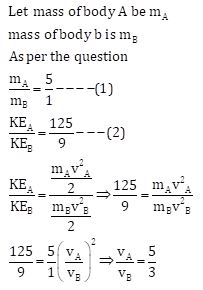
Question 14
A car is running at a speed of 15 km h-1 while another similar car is moving at a speed of 45 km h-1. Find the ratio of their kinetic energies.
Answer 14
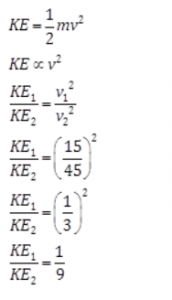
Question 15
A ball of mass 0.5 kg slows down from a speed of 5m/s-1 to that of 3m/s-1. Calculate the change in kinetic energy of the ball.
Answer 15
Mass of ball = 0.5 kg
Initial velocity = 5 m / s
Initial kinetic energy = 1 / 2 × mass × (velocity)2
= 1 / 2 × 0.5 × (5)2
= 1 / 2 × 0.5 × 25
= 6.25 J
Final velocity of the ball = 3 m / s
Final kinetic energy of the ball = 1 / 2 × mass × (velocity)2
= 1 / 2 × mass × (velocity)2
= 1 / 2 × 0.5 × (3)2
= 1 / 2 × 0.5 × 9
= 2.25J
So, change in the kinetic energy of the ball = 2.25 J – 6.25 J
= – 4J
Hence,
there is a decrease in the kinetic energy of the ball.
Question 16
A canon ball of mass 500 g is fired with a speed of 15m/s-1. Find: (i) its kinetic energy and (ii) its momentum.
Answer 16
A mass of cannon ball = 500 g
= 0.5 kg
Speed, v = 15 m / s
(a) Kinetic energy of ball = 1 / 2 × mass × (velocity)2
= 1 / 2× 0.5 × (15)2
= 1 / 2 × 0.5 × 225
= 56.25J
(b) Momentum of the ball = mass × velocity
= 0.5 × 15
= 7.5 kgm/s
Question 17 (Exe-2B and 2C Work Energy and Power ICSE)
A body of mass 10 kg is moving with a velocity 20m s-1. If the mass of the body is doubled and its velocity is halved, find: (i) the initial kinetic energy, and (ii) the final kinetic energy.
Answer 17
Let initial Mass, m1= 10kg and velocity, v1 =20 m/s
Final mass, m2=2 x10=20 kg and velocity, v2=20/2= 10m/s
Initial kinetic energy, K1 = 1 / 2 × mass × (velocity)2
= 1 / 2 × 10 × (20)2
= 1 / 2 × 10 × 20 × 20
= 2000J
Final kinetic energy, K2 = 1 / 2 × mass × (velocity)2
= 1 / 2 × 20 × (10)2
= 1 / 2 × 20 × 10 × 10
= 1000J
Therefore K1 / K2 = 2000 / 1000
= 2 / 1
= 2: 1
Question 18
A truck weighing 1000 kgf changes its speed from 36 km/h-1 to 72 km/h-1 in 2 minutes. Calculate: (i) the work done by the engine and (ii) its power.(g =10 m/s–2)
Answer 18
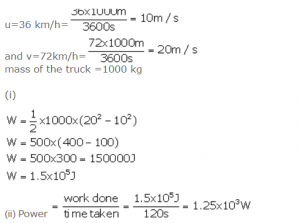
Question 19
A body of mass 60 kg has the momentum 3000 kgm/s-1. Calculate: (i) the kinetic energy and (ii) the speed of the body.
Answer 19
Mass of body = 60 kg
Momentum, p = 3000 kgm / s
(a) Kinetic energy = p2 / 2m
= (3000)2 / 2 × 60
= (3000 × 3000) / 120
= 75000J
= 7.5 × 104J
(b) Momentum = mass × velocity
3000 = 60 × velocity
Velocity = 3000 / 60
Velocity = 50 m / s
Question 20
How much work is needed to be done on a ball of mass 50 g to give it a momentum of 5 kg m s-1 ?
Answer 20
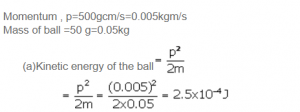
Question 21
How much energy is gained by a box of mass 20 kg when a man
(a) carrying the box waits for 5 minutes for a bus?
(b) runs carrying the box with a speed of 3 m/s-1 to catch the bus?
(c) raises the box by 0.5 m in order to place it inside the bus? (g=10 m/s–2)
Answer 21

Question 22 (Exe-2B and 2C Work Energy and Power ICSE)
A bullet of mass 50g is moving with a velocity of 500m/s-1. It penetrates 10 cm into a still target and comes to rest. Calculate: (a) the kinetic energy possessed by the bullet, and (b) the average retarding force offered by the target.
Answer 22
Mass of bullet = 50 g
= 0.05 kg
Velocity = 500 m / s
Distance penetrated by the bullet = 10 cm
= 0.1 m
(a)
The kinetic energy of the bullet = 1 / 2 × mass × (velocity)2
= 1 / 2 × 0.05 × (500)2
= 1 / 2 × 0.05 × 500 × 500
= 6250J
(b)
Work done by the bullet against the material of the target = resistance force × distance
6250 = resistance force × 0.1 m
Resistance force = 62500 N
Question 23
A spring is kept compressed by a small trolley of mass 0.5 kg lying on a smooth horizontal surface as shown. When the trolley is released, it is found to move at a speed of v = 2 m/s-1. What potential energy did the spring possess when compressed?
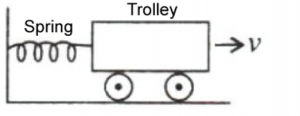
Answer 23
Mass of trolley = 0.5 kg
Velocity = 2 m / s
When the compressed spring is released, its potential energy is converted into kinetic energy completely.
Potential energy of compressed spring = kinetic energy of moving trolley
Kinetic energy of trolley = 1 / 2 × mass × (velocity)2
= 1 / 2 × 0.5 × (2)2
= 1 / 2 × 0.5 × 2 × 2
= 1J
So, potential energy of compressed spring = 1.0J
Exe -2(C) Work, Energy and Power ICSE Physics
Exe-2B and 2C Work Energy and Power ICSE Class-10 Concise
Page 46
Question 1
State the Principle of conservation of energy.
Answer 1
According to the law of conservation of energy, energy can neither be created nor can it be destroyed. It only changes from one form to another.
Question 2
What do you understand by the conservation of mechanical energy? State the condition under which the mechanical energy is conserved.
Answer 2
According to the law of conservation of mechanical energy, whenever there is an interchange between the potential energy and kinetic energy, the total mechanical energy (i.e., the sum of kinetic energy K and potential energy U) remains constant i.e., K + U = constant when there are no frictional forces.
Mechanical energy is conserved only when there are no frictional forces for a given system (i.e. between body and air). Thus, conservation of mechanical energy is strictly valid only in vacuum, where friction due to air is absent.
Question 3
Name two examples in which the mechanical energy of a system remains constant.
Answer 3
Motion of a simple pendulum and motion of a freely falling body.
Question 4
A body is thrown vertically upwards. Its velocity keeps on decreasing. What happens to its kinetic energy as its velocity becomes zero?
Answer 4
Kinetic energy of the body changes to potential energy when it is thrown vertically upwards and its velocity becomes zero.
Question 5
A body falls freely under gravity from rest. Name the kind of energy it will possess
(a)At the point from where it falls.
(b)While falling
(c)On reaching the ground.
Answer 5
(a)Potential energy
(b)Potential energy and kinetic energy
(c)Kinetic energy
Question 6 (Exe-2B and 2C Work Energy and Power ICSE)
Show that the sum of kinetic energy and potential energy (i.e., total mechanical energy) is always conserved in the case of a freely falling body under gravity (with air resistance neglected) from a height h by finding it when (i) the body is at the top, (ii) the body has fallen a distance x, (iii) the body has reached the ground.
Answer 6
Let a body of mass m be falling freely under gravity from a height h above the ground (i.e., from position A). Let us now calculate the sum of kinetic energy K and potential energy U at various positions, say at A (at height h above the ground), at B (when it has fallen through a distance x) and at C (on the ground).
Page 47
Question 7
A pendulum is oscillating on either side of its rest position. Explain the energy changes that take place in the oscillating pendulum. How does the mechanical energy remain constant in it? Draw necessary diagram.
Answer 7
When the bob swings from A to B, the kinetic energy decreases and the potential energy becomes maximum at B where it is momentarily at rest.

From B to A, the potential energy again changes into the kinetic energy and the process gets repeated again and again.
Thus while swinging, the bob has only the potential energy at the extreme position B or C and only the kinetic energy at the resting position A. At an intermediate position (between A and B or between A and C), the bob has both the kinetic energy and potential energy, and the sum of both the energies (i.e., the total mechanical energy) remains constant throughout the swing.
Question 8 (Exe-2B and 2C Work Energy and Power ICSE)
A pendulum with bob of mass m is oscillating on either side from its resting position A between the extremes B and C at a vertical height h above A. What is the kinetic energy K and potential energy U when the pendulum is at positions (i) A, (ii) B and (iii) C?
Answer 8
(a)At position A, pendulum has maximum kinetic energy and its potential energy is zero at its resting position. Hence, K=mgh and U= 0.
(b)At B, kinetic energy decreases and potential energy increases. Hence, K= 0 and U=mgh
(c)At C also, kinetic energy K= 0 and potential energy U=mgh.
Question 9
Name the type of energy possessed by the bob of a simple pendulum when it is at (a) the extreme position, (b) the mean position, and (c) between the mean and extreme positions.
Answer 9
(a)Extreme position: Potential energy
(b)Mean position: Kinetic energy
(c)Between mean and extreme: Both kinetic energy and potential energy
MCQs- 2 (C) Work Energy and Power ICSE Selina Solutions Chapter-2
Exe-2B and 2C Work Energy and Power ICSE Class-10 Concise
Page 47
Question 1
A ball of mass m is thrown vertically up with an initial velocity so as to reach a height h. The correct statement is:
(a) Potential energy of the ball at the ground is mgh.
(b) Kinetic energy to the ball at the ground is zero.
(c) Kinetic energy of the ball at the highest point is mgh.
(d) Potential energy of the ball at the highest point is mgh.
Answer 1
(d) Potential energy of the ball at the highest point is mgh.
Question 2
A pendulum is oscillating on either side of its rest position. The correct statement is :
(a) It has only the kinetic energy at its each position.
(b) It has the maximum kinetic energy at its extreme position.
(c) It has the maximum potential energy at its mean position.
(d) The sum of its kinetic and potential energy remains constant throughout the motion.
Answer 2
(d) The sum of its kinetic and potential energy remains constant throughout the motion.
Numericals-2 (C) Physics Selina Solution Work, Energy and Power
Exe-2B and 2C Work Energy and Power ICSE Class-10 Concise
Page 47
Question 1
A ball of mass 0.20 kg is thrown vertically upwards with an initial velocity of 20m/s-1. Calculate the maximum potential energy it gains as it goes up.
Answer 1
Potential energy at the maximum height= initial kinetic energy 1/2 mv²
1/2* 0.20* 0*20*20 = 40 J
Question 2
A stone of mass 500g is thrown vertically upwards with a velocity of 15m/s-1. Calculate: (a) the potential energy at the greatest height, (b) the kinetic energy on reaching the ground (c) the total energy at its half way point.
Answer 2
(a) Potential energy at maximum height = initial kinetic energy
mgh = 1 / 2 mv2
= 1 / 2 × 0.500 × 15 × 15
= 56.25J
(b) Kinetic energy on reaching the ground = potential energy at the greatest height
= 56.25J
(c) Total energy at its halfway point = 1 / 2 (K + U)
= 56.25J
Question 3
A metal ball of mass 2kg is allowed to fall freely from rest from a height of 5m above the ground.
(a) Taking g = 10m/s2, calculate:
(i) the potential energy possessed by the ball when it is initially at rest.
(ii) the kinetic energy of the ball just before it hits the ground?
(b)What happens to the mechanical energy after the ball hits the ground and comes to rest?
Answer 3
(a)
(i) Potential energy of the ball =mgh
=2 x 10 x 5=100J
(ii)Kinetic energy of the ball just before hitting the ground = Initial potential energy= mgh=2x10x5=100J
(b)Mechanical energy converts into heat and sound energy.
Question 4
The diagram given below shows a ski jump. A skier weighing 60kgf stands at A at the top of ski jump. He moves from A and takes off for his jump at B.
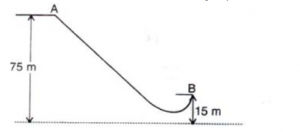
(a) Calculate the change in the gravitational potential energy of the skier between A and B.
(b) If 75% of the energy in part (a) becomes the kinetic energy at B, calculate the speed at
which the skier arrives at B.
(Take g = 10 m s-2).
Answer 4
(a) Mass of skier = 60 kg
Loss in potential energy = mg (h1 – h2)
= 60 × 10 × (75 – 15)
= 60 × 10 × 60
= 3.6 × 104J
(b) Kinetic energy at B = 75 / 100 × 3.6 × 104
= 27000J
= 2.7 × 104J
Kinetic energy = 1 / 2 mv2
27000 = 1 / 2 mv2
27000 = 1 / 2 × 60 × v2
v2 = 27000 / 30
= 900
= 30 m / s
Question 5 (Exe-2B and 2C Work Energy and Power ICSE)
A hydroelectric power station takes its water from a lake whose water level is 50m above the turbine. Assuming an overall efficiency of 40%, calculate the mass of water which must flow through the turbine each second to produce power output of 1MW.
(g=10 m s-2).
Answer 5
Potential energy = mgh
Efficiency = 40 %
Useful work done = 40 % of potential energy
= 40 / 100 (mgh)
= 0.4 (m × 10 × 50)
= 200 m
Power = work done per second
1MW = 200 × mass of water flowing each second
1 × 106W = 200 × mass of water flowing each second
mass of water flowing each second = (1 × 106) / 200
= 5000 kg
Question 6
The bob of a simple pendulum is imparted a velocity of 5m s-1 when it is at its mean position. To what maximum vertical height will it rise on reaching at its extreme position if 60% of its energy is lost in overcoming the friction of air?
(Take g = 10 m s-2).
Answer 6

Return to Concise Selina ICSE Physics Class-10
Thanks


